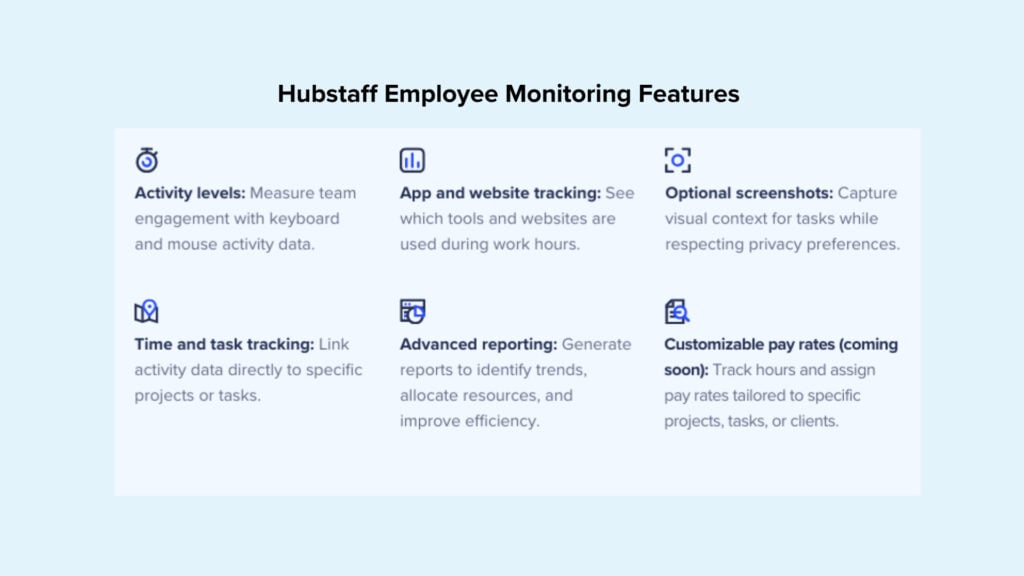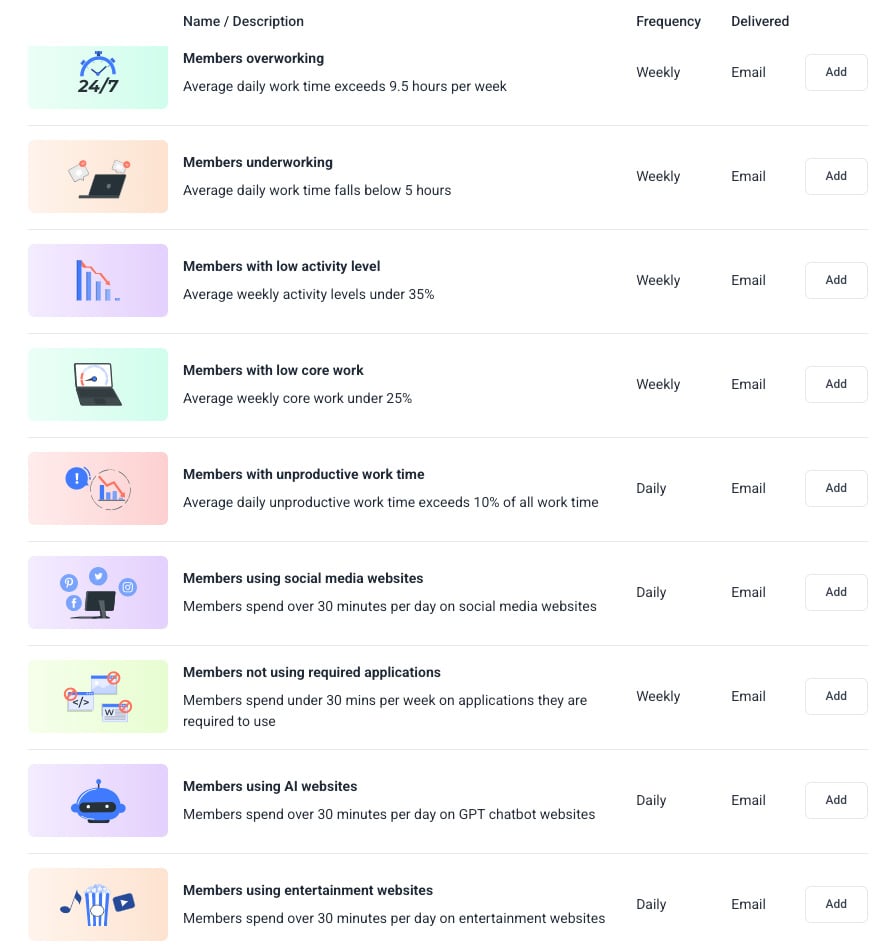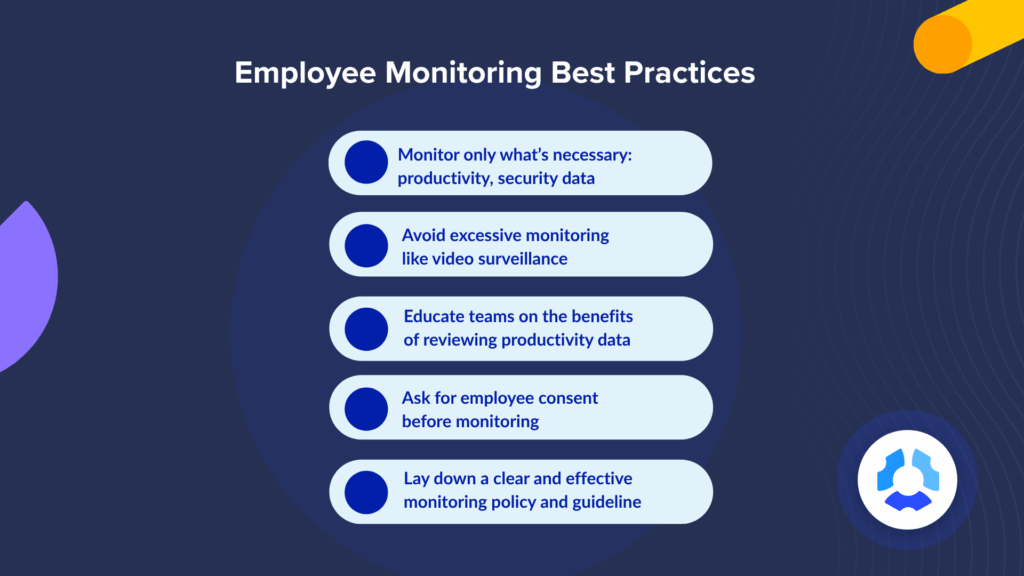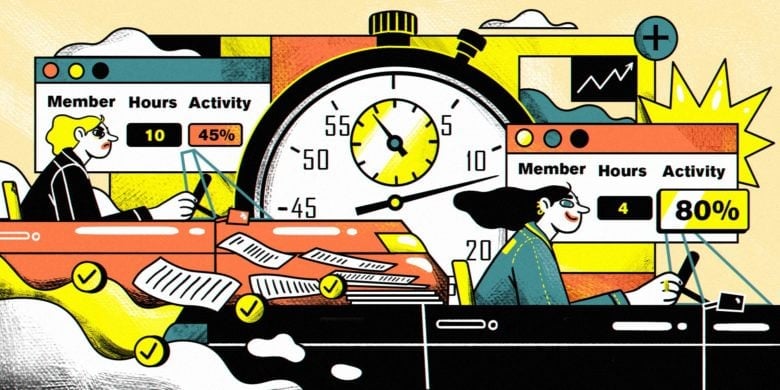Why do we need employee monitoring and workplace security?
Companies had to adapt fast when the world shifted to remote work during the pandemic, but now that the dust has settled, it’s surprising that teams still lack the basic security functions needed to fully assimilate to remote work.
Now, with hybrid and distributed teams becoming the norm, a new challenge has taken center stage: How do you measure productivity, stay compliant, and protect sensitive data when your team isn’t all in one place?
More leaders are turning to practical employee monitoring tools to track time or streamline workflows and safeguard against insider threats, data breaches, and compliance risks from a dispersed workforce to solve this.
According to Upwork, adopting productivity tracking tools can assist managers in monitoring performance effectively.
But here’s the catch: how you monitor employees matters as much as what you monitor. If employee monitoring feels like surveillance, it can damage trust and morale.
In this guide, we’ll cover everything you need to know about workplace monitoring — from picking the right monitoring tools to implementing them to support your people while protecting your business.
Boost your team’s efficiency with Hubstaff's productivity tools
Why effective employee monitoring matters for workplace security
Employee monitoring refers to overseeing employee activities, collecting productivity insights, and work habits using monitoring software tools. It is a crucial step for ensuring workplace safety and security.
Ethical workplace monitoring helps organizations safeguard against potential breaches and helps create a secure work culture — especially for teams scattered across the globe.
A 2024 Insider Threat Report by Cybersecurity Insiders reveals that 83% of organizations experienced at least one insider attack within the past year.
When you don’t have visibility into a remote team’s workday, you don’t know if data is being transferred, crucial company information is being shared, or unintentional website visits are leading to cyber attacks.
Here’s a quick breakdown of how workplace monitoring helps boost business safety and security.
- Monitor employee communications to report on sensitive data sharing and prevent potential breaches.
- Alerts on unusual activities and suspicious login attempts across internal teams.
- Employee monitoring tools bind teams with compliance best practices tied to business safety.
- It helps detect fraudulent activities like leaking sensitive company data to competitors.
- The security team gets real-time access to employee activities and takes action on potential threats.
Balancing productivity, employee privacy, and security
When it comes to employee monitoring, a lot of teams may raise concerns. According to Forbes, 43% of survey respondents felt that workplace surveillance negatively affects company culture.
These concerns around monitoring stem from the following:
- Lack of transparency
- Fear of micromanagement
- The potential threat of personal data misuse
- Productivity loss due to constant fear of surveillance
Companies need to address these concerns to implement employee monitoring correctly. By analyzing the pros and cons of employee monitoring, leaders can choose the right tools.
Here are a few workforce tracking best practices to follow:
- Be transparent with your team on employee monitoring and how their data is used.
- Monitor employees on what’s necessary and reasonable: productivity, security, or compliance.
- Avoid excessive monitoring practices like video surveillance and tracking activities after work hours.
- Educating teams on the benefits of reviewing activity and productivity data can increase job satisfaction and help them work smarter.
- Keep open communication with your team and ask for employee consent. You want them onboarded with your plan, not against it.
- Ask for feedback and consider your team’s views on excessive tracking measures.
- Lay down a clear and effective monitoring policy and guideline, aligning with team inputs.
Before installing employee monitoring tools, federal and state laws and regulations should also be considered. Inform employees and create an ethical computer monitoring policy that they can follow.
Instead of micromanaging, when implemented right, employee monitoring systems can help:
- Build accountability in remote teams, boost performance and team workflows.
- Identify hidden bottlenecks and improve operational efficiencies.
- Track workloads, saving overworked team members from potential burnout.
How employee monitoring software works
Hubstaff’s time tracking with built-in employee monitoring tools enhance team accountability and give you clear visibility into how your teams work. One of its main goals is to support team morale.
The Hubstaff Workstyle Revolution Report captures insights from over 22,000 organizations and 185,000 workers and shows how features like Focus time, task breakdowns, and productivity metrics help teams improve productivity and accountability.

Here are the key Hubstaff workplace monitoring features designed to give you visibility and boost your team’s accountability.
Time tracking
Time is money, and with Hubstaff employee time tracking, you can track time directly to tasks to see the precise, real-time time and expenses tied to a project.
Hubstaff automatically generates timesheets the second you start tracking time. Add notes, manual time entries, and submit for approval. Approvals trigger streamlined payments directly from the Hubstaff app to your favorite payroll tools like PayPal, Gusto, and Deel.
APP and URL tracking
Know exactly how your team spends their workday. With Hubstaff’s activity tracking features, you can monitor employee activity through app and URL usage to gain visibility into productivity patterns across your organization.
As team members go about their tasks, Hubstaff captures the time spent on each application and website, giving you a clear picture of digital activity throughout the day. This data empowers you to spot productivity dips, reinforce accountability, and tighten workflows.
With Insights, you can categorize productive and unproductive app and help spot potential security risks from unauthorized or unproductive website visits. Teams also have access to their data, an element that is crucial for building a culture of transparency and trust without micromanagement.
Screenshot Capture
Gain complete visibility into how efficiently work gets done without compromising flexibility. Hubstaff lets you capture employee screenshots during tracked time, offering a transparent view of daily activity while respecting team autonomy.
As a manager, you’re in complete control of what data you track. Here are some examples of changes you can make to suit your management style:
- Enable or disable at the individual level with role-based access.
- Set screenshot frequency to your preference or keep the default 3 per 10 minutes.
- You can toggle on the screenshot blur feature to keep employee privacy in mind.
- Explore the screenshots add-on for more frequent captures.
This functionality is built to improve accountability and support compliance needs, not to micromanage. With customizable settings, Hubstaff empowers teams to work openly and efficiently on their terms.
Activity level monitoring
With activity level measurement in Hubstaff, you’ll have some tangible data on how productive your team is while tracking time to specific tasks. Hubstaff’s activity level monitoring analyzes the frequency of keyboard and mouse usage during work sessions to calculate a percentage-based activity score for each user.
- Activity levels are calculated based on keyboard interactions (not specific keystrokes) and mouse movement during active time.
- Activity levels may vary for different roles. (i.e., managers spending time in meetings and those doing data entry will have very different activity).
- Industry-based activity benchmarking allows you to evaluate your organization’s activity levels compared to other organizations in the same industry. Set realistic expectations, detect productivity spikes or drops, and identify efficiency gaps early.
Note: Activity scores naturally vary based on industry and job responsibilities. Writing code, reading reports, or jumping on client calls are all crucial parts of one’s day-to-day, so a 25% rate can be just as productive as a 75% rate. Activity rates are no replacement for good management. What matters is the context.
Idle time detection
Stay on top of work-time accuracy, prevent money leaks, and prevent productivity loss with Idle time. Hubstaff’s Idle time tracking is built to spot keyboard and mouse inactivity. Identify unproductive time, reduce manual errors, and tighten team accountability — especially in remote or hybrid environments.
- Set custom idle timeouts to intervals of 5, 10, or 20 minutes, or disable entirely.
- Personalize specific parameters for individual users based on their job duties.
- Prevent time theft, buddy punching, and unintentional overbilling.
Idle detection helps in everyday scenarios like:
- Forgetting to stop the timer after work
- Taking breaks, stepping away for calls, or reviewing physical documents
- Going idle unintentionally while the timer runs
With these safeguards in place, your team stays focused, your data stays clean, and your operations run more efficiently without constant oversight.
Weekly work limits
Keep labor costs predictable and prevent burnout with Hubstaff’s flexible work limit settings. You can define the number of hours employees are allowed to work each day, week, or within their scheduled shift to help you stay aligned with budgets and compliance goals.
- Set limits on daily, weekly, or scheduled shift hours.
- Automated enforcement (Hubstaff stops tracking once the time limit is reached, e.g., after 40 hours).
- Adjust settings to edit, override, or remove limits as workloads change.

This isn’t a cheat detection system; it’s a behavior insight tool. By identifying anomalies while trusting your team to perform at their best, you can create a secure and transparent work environment.
Smart notification
Stay informed and proactive with Hubstaff’s smart notification system. These alerts help you track team dynamics in real time and flag signs of overwork, underperformance, and unusual behavior so you can take timely action.
- Receive notifications for overwork, low activity, and other productivity shifts.
- Customize triggers to specific metrics like core work, activity rate, app usage, or URLs.
- Get location-based alerts for teams working in the field through GPS tracking.

Smart notifications can be set up for metrics like:
- Daily work time
- Core, non-core, and unproductive work
- Activity rate
- App and URL usage (even for custom-specified sites)
- Suspicious applications
By surfacing these insights, Hubstaff helps you lead with data and get a pulse on team productivity.
Integrations
Connect your favorite tools to create a unified, automated workflow. Hubstaff integrates with over 35 project management, communication, and payroll tools to streamline your operations and keep your team in sync.
- Leverage an asynchronous work environment for remote teams (track time directly within tools like Trello, Asana, Jira, Slack, QuickBooks, and more).
- You can auto-sync time logs to the platforms you already use.
- Centralized data productivity across systems for better decision-making.
These integrations minimize manual work, increase team alignment, and let you manage productivity from a single source of truth.
Hubstaff Insights
Try the Hubstaff Insights add-on for added workforce analytics features like utilization rates, unusual activity detection, and more. Let’s take a closer look.
Unusual activity detection
Protect your organization from suspicious activity with Hubstaff’s unusual activity detection, which is available with the Insights add-on. This feature automatically flags employee behavior around work that significantly deviates from standard activity patterns, helping you ensure compliance without micromanaging.
Unusual activity can:
- Detect signs of software or devices that mimic mouse and keyboard movement to manipulate activity rates.
- Flag users who exceed 95% activity for extended periods, which is highly uncommon.
- Distinguishes between potential time fraud and legitimate high-intensity work.
For example, a software developer debugs complex code and continuously types and navigates tools while moving their keyboard and/or mouse for over 95% (not moving the keyboard or mouse for 5%) of 35 minutes.
Note: While exceeding 95% of the activity level is rare, some team members may go over this level for 30-60 minutes. However, members exceeding 95% activity for over 60 minutes are rare.

This isn’t a cheat detection system; it’s a behavior insight tool. By identifying anomalies, you can create a secure and transparent work environment while trusting your team to perform at their best.
Utilization rates
As your team tracks time throughout the workday, Insights provides a complete overview of how your team works with work time classifications.
- Focus time (uninterrupted work sessions over 30 minutes)
- Core work (time spent on job-specific, high-priority tasks),
- Non-core work (activities that extend one’s primary job responsibilities).
These data points are available for you to use. The data can help you find bottlenecks and task delays if teams have too much on their plates or are occupied with too much non-core work, like unnecessary meetings.
Hubstaff’s approach to secure, transparent employee monitoring
Hubstaff time tracking platform with employee and productivity monitoring features is built with transparency and flexibility. While monitoring is one of our primary features, flexibility and employee well-being are our top priorities.
Here’s our approach to employee monitoring:
- Emphasize transparency. Employees can view their own screenshots and tracked data with no keystroke logging, email, or webcam monitoring.
- Customizable monitoring controls. Managers and team leads can adjust monitoring settings (frequency, blur, permissions) by team or individual, empowering ethical, configurable oversight.
- Privacy-first: Monitoring is only during work hours. No tracking is allowed outside active sessions.
- Compliance: Supports secure record-keeping for audits and regulatory needs.
Real-world benefits of workforce monitoring
Hubstaff employee monitoring methods are designed with practical security and productivity gains in mind.
Improved employee productivity and accountability
Features like time tracking with work classifications, smart notifications, and app/URL tracking help teams stay focused and ensure time is used effectively. Idle time detection further ensures employees are active when logging time.
Early detection of risky behavior or security threats
Unusual activity detection and smart notifications flag anomalies like excessively high activity levels or suspicious app/URL use to enable quick, proactive responses to potential threats.
Prevention of time theft and overtime abuse
Idle timeouts, weekly work limits, and optional screenshot capture prevent artificial time logs to ensure teams get paid accurately, and help avoid unauthorized overtime.
Support for compliance audits
Automated time reports, in-depth activity log details, and customizable tracking provide a clear audit trail. This supports regulatory compliance and ease documentation burdens.
Enhanced trust through clear, fair policies
Role-based access, optional screenshot settings, and employee visibility into their data promote transparency, helping monitoring feel supportive rather than invasive. Hubstaff is compliant with employee monitoring laws and legal regulations, with the goal of promoting ethical monitoring practices.
Best practices for employee monitoring
Employee monitoring is a leadership responsibility that should be practiced with empathy and transparency. Effective workplace monitoring means communicating the agenda behind monitoring, what you plan to track, and how you’ll use the data you collect.
Moreover, learning about monitoring privacy policies, stats, and tools can help implement a compliant workplace privacy and employee monitoring program. To ensure ethical monitoring, look to monitor with a legitimate business purpose. It’s also crucial to stay informed on local and national laws like the:
- General Data Protection Regulation (GDPR)
- Electronic Communications Privacy Act (ECPA)
- Personal Information Protection and Electronic Documents Act (PIPEDA)

Respect for privacy is essential to building trust. With Hubstaff, that trust is built through respect. With added features, you can promote monitoring practices without being intrusive.
- Blur apps, URLs, and screenshots to maintain employee focus without violating privacy.
- No keystroke logging, email monitoring, video recording, or webcam access.
- Give employees visibility into their data to encourage collaboration, not control.
Follow employee monitoring laws and regulations to fuel a positive team culture and seek legal counsel if anything is unclear. It’s also important to monitor employees’ performance while nurturing a workplace culture of autonomy and accountability.
Partnering with Hubstaff for reliable employee monitoring and security solutions
Hubstaff offers a comprehensive, customizable platform that balances performance visibility with employee data privacy. Whether you’re managing a remote team, scaling operations, or reinforcing data security, Hubstaff equips you with the tools to lead confidently.
Take Mr Digital, for example:
Company: Mr Digital is a global digital marketing agency with a remote team of 16 employees across multiple countries.
Challenge: Managing a fast-growing, fully remote team while maintaining productivity, accountability, and visibility across time zones.
Solution: Adopted Hubstaff’s employee monitoring and time tracking tools to reduce meeting time, enhance performance insights, track project profitability, and motivate team members through transparent activity metrics.
Result: Mr Digital reduced meeting time by 10%, increased team activity by 10%, and gained the confidence to run a fully remote global agency using Hubstaff.
FAQ Section
1. How do you create a fair employee monitoring policy?
To create a fair employee monitoring policy, focus on transparency, open communication, and employee privacy. Avoid intrusive practices like video surveillance, webcam usage, keystroke logging, etc. Choose an employee monitoring tool like Hubstaff that can blur screenshots, role-based data access, HIPAA, GDPR compliance, and enterprise-grade encryption.
2. How does Hubstaff protect employee privacy while monitoring work activity?
Hubstaff protects employee privacy without compromising ethical monitoring. Employees have complete control over their data and transparency in what’s being tracked. They can start and stop the timer, delete time entries and screenshots, and are notified when tracking starts and screenshots are taken. Hubstaff employee monitoring methods also focus on tracking time and activity rather than logging keystrokes or monitoring personal communications. The data collected is limited to work hours only.
3. How customizable is Hubstaff’s monitoring for different teams or roles?
Hubstaff offers monitoring features tailored to different roles within your organization. Each role has different capabilities; managers can enable blur screenshots, set screenshot frequency, customize the idle timeout duration, etc. But users don’t have these controls. However, everyone can view their time tracking details, activity levels, focus time, core work percentages, etc.
4. How customizable is Hubstaff’s monitoring for different teams or roles?
When choosing employee monitoring tools, look for features supporting productivity and employee trust. Key capabilities to consider include:
- Time tracking: Accurate time tracking is essential, especially for remote or hybrid teams. Look for tools that offer manual and automatic time logging, idle detection, and integrations with project management platforms.
- GPS tracking: For field teams or mobile employees, GPS tracking helps ensure accountability and route transparency without micromanagement.
- Activity monitoring: Choose software that tracks activity levels, app usage, and website visits with customizable settings. It should allow flexibility to monitor what matters most without overstepping privacy.
- Privacy & compliance controls: The best tools comply with regulations like GDPR. Look for options that include blurred screenshots, customizable permissions, and transparent reporting so team members know what’s being tracked.
- Productivity insights & reports: Dashboards and reports that provide insights into time spent per task, app usage trends, and team efficiency are invaluable for improving workflows and identifying bottlenecks.
- User-friendly interface: An intuitive, easy-to-use interface boosts adoption and reduces training time.
- Scalability & integration: Ensure the software can grow with your team and integrate seamlessly with your existing tools (e.g., payroll, CRM, project management).
Comprehensive computer monitoring software empowers your team, enhances productivity, and protects privacy, fostering a culture of accountability and transparency.
Most popular
5 Office Distractions in the Workplace and How to Manage Them
Office distractions have been a consistent barrier to productivity, costing U.S. businesses an estimated $650 billion annually in...
Common Hubstaff Misconceptions: Debunking Myths
Time tracking software myths are everywhere — and you’ve probably heard a few yourself. When people hear the word “t...
Employee Surveillance vs. Productivity Monitoring: Why the Distinction Matters
Leaders are under constant pressure to keep teams productive, but when they bring up monitoring tools, a red flag goes up. There�...
The Effects of Productivity Tracking on Employees (Pros & Cons)
How do you know if work is moving forward or just moving? That’s the question employee productivity tracking attempts to answer....




